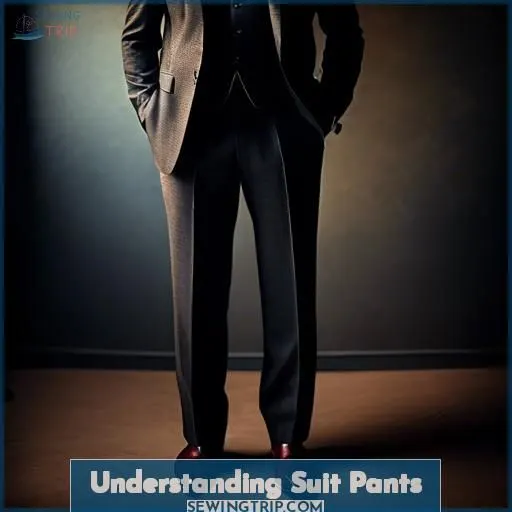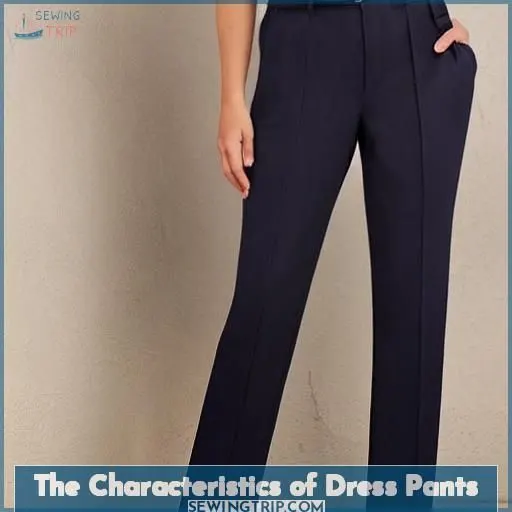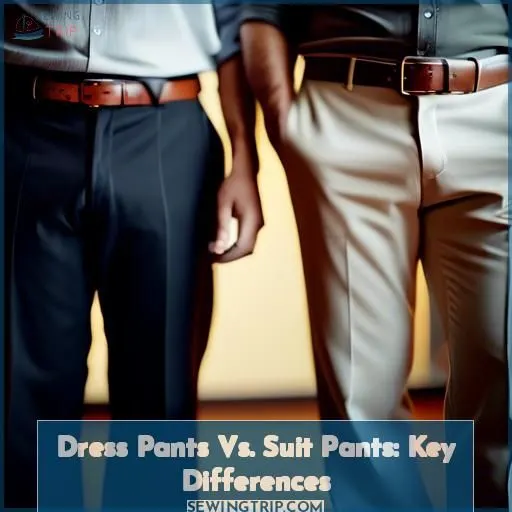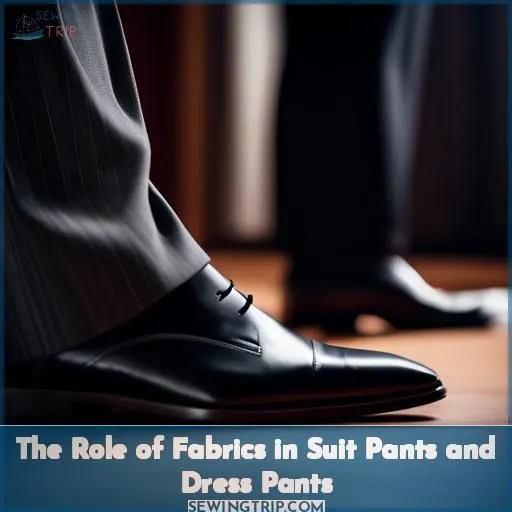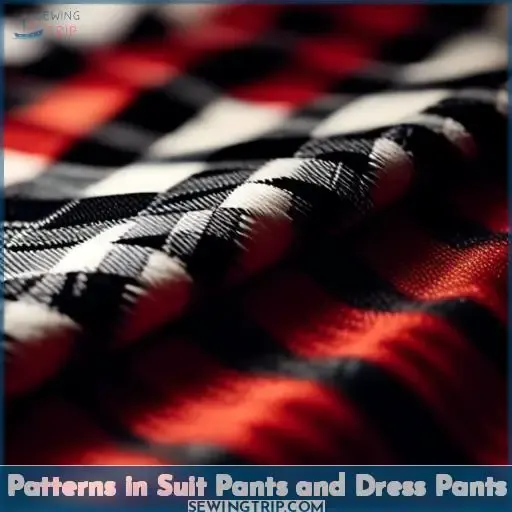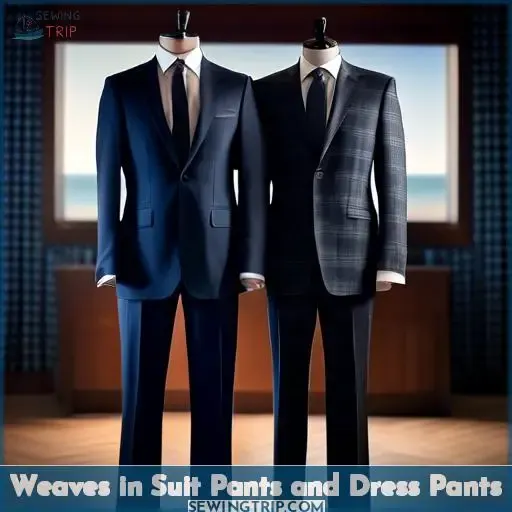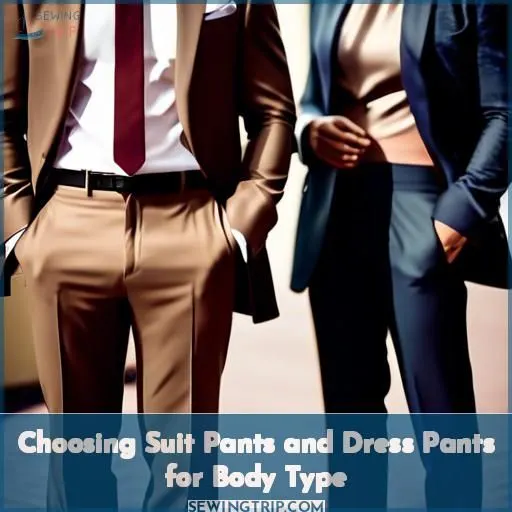This site is supported by our readers. We may earn a commission, at no cost to you, if you purchase through links.
 Suit pants and dress pants differ significantly in their purpose and design.
Suit pants and dress pants differ significantly in their purpose and design.
Suit pants are tailored for formal occasions.
They often feature patterns like pinstripes or glen plaids, a higher rise, and heavier fabrics like wool.
Suit pants demand a matching jacket.
In contrast, dress pants prioritize versatility.
They are crafted from lighter, breathable materials like cotton or linen in solid colors.
Dress pants effortlessly transition from dressed-up to casual settings.
Understanding these differences between suit pants and dress pants ensures you’ll make the right sartorial choice for any occasion.
But there’s more to explore in the nuances of these wardrobe essentials.
Table Of Contents
- Key Takeaways
- Understanding Suit Pants
- The Characteristics of Dress Pants
- Dress Pants Vs. Suit Pants: Key Differences
- The Role of Fabrics in Suit Pants and Dress Pants
- Patterns in Suit Pants and Dress Pants
- Weaves in Suit Pants and Dress Pants
- Wearing Suit Pants Without the Jacket
- Styling Suit Pants and Dress Pants
- Choosing Suit Pants and Dress Pants for Body Type
- The Evolution of Slacks in Men’s Fashion
- Frequently Asked Questions (FAQs)
- Conclusion
Key Takeaways
- Suit pants are designed for formal occasions, often featuring patterns like pinstripes or glen plaids, tailored from heavier fabrics such as wool, and require a matching jacket.
- Dress pants prioritize versatility, crafted from lighter, breathable materials like cotton or linen in solid colors, and can transition from formal to casual settings easily.
- The choice of fabric plays a significant role in the functionality and suitability of suit pants and dress pants for different weather conditions and occasions.
- Tailoring and fit are crucial for both suit pants and dress pants, with suit pants offering a more formal, fitted look, while dress pants provide a balance between comfort, style, and versatility.
Understanding Suit Pants
Diving into the world of suit pants, you’re stepping into a realm where formality meets finesse. These aren’t your average slacks; they’re the secret sauce to looking sharp.
Suit pants come in a variety of fabrics, each chosen for its ability to elevate your look. From the sleek lines of wool to the subtle sheen of silk, the right fabric can turn heads.
And let’s talk patterns – whether it’s the classic pinstripe that whispers power or the bold glen plaid that shouts confidence, suit pants offer a pattern for every personality.
But it’s not just about looking good; it’s about feeling good. Tailoring is key. A well-fitted pair of suit pants can make you feel like you’re wearing armor, ready to conquer the boardroom or charm at a cocktail party.
The Characteristics of Dress Pants
Dress pants are a staple in any man’s wardrobe, offering versatility and style for various occasions.
- Fabric Choice: Dress pants can be made from a variety of materials, such as wool, cotton, or synthetic blends. Wool is known for its moisture-wicking properties and warmth, while cotton is more breathable and less expensive. Synthetic materials can be a great option for those seeking comfort and durability.
- Fit Considerations: Dress pants should fit snugly but not too tightly, allowing for comfort and ease of movement. The rise, crotch, and seat should all be considered for a proper fit.
- Styling Options: Dress pants can be dressed up or down depending on the occasion. They can be paired with dress shoes, a suit jacket, and tie for formal events, or casually with sneakers or loafers.
- Pairing Suggestions: Dress pants can be worn with a variety of tops, from dress shirts for business casual or semi-formal settings, to a simple t-shirt for a casual look.
- Fabric: Dress pants can be made from various fabrics, including cotton, wool, and synthetic blends. Wool is known for its moisture-wicking properties and warmth, cotton is more breathable and less expensive, and synthetic materials can offer comfort and durability.
- Fit: Dress pants should fit snugly but not too tightly, allowing for comfort and ease of movement. The rise, crotch, and seat should all be considered for a proper fit.
- Styling: Dress pants can be dressed up or down depending on the occasion. They can be paired with dress shoes, a suit jacket, and tie for formal events, or casually with sneakers or loafers.
- Pairing: Dress pants can be worn with a variety of tops, from dress shirts for business casual or semi-formal settings, to a simple t-shirt for a casual look.
When choosing dress pants, consider the fabric, fit, and styling options that best suit your needs and preferences. Remember, the key to a great pair of dress pants is finding the right balance between comfort, style, and versatility.
Dress Pants Vs. Suit Pants: Key Differences
As you’ve just seen, dress pants are the chameleons of your wardrobe, blending seamlessly from boardroom to bar. But let’s shift gears to their close relatives, suit pants, and how they stand apart. You’ll find that suit pants are like the loyal sidekick to your suit jacket, rarely stepping out solo.
- Patterns: Suit pants often boast patterns like pinstripes, setting them apart from the usually solid-colored dress pants.
- Weaves: The fabric’s weave can hint at its identity, with twill for suit pants and sometimes gabardine for dress pants.
- Rise: Suit pants typically have a higher rise, giving a nod to their formal roots.
- Wardrobe Role: While dress pants mingle with other pieces, suit pants are more exclusive, preferring the company of their matching jacket.
The Role of Fabrics in Suit Pants and Dress Pants
When it comes to suit pants and dress pants, the role of fabrics is crucial in determining their quality, durability, wrinkle resistance, moisture wicking, and breathability. Suit pants are often made from heavier materials like wool or corduroy, which makes them suitable for colder weather and more comfortable. On the other hand, dress pants are typically made from lighter materials like cotton, linen, or polyester, which allows for a slimmer fit and better breathability.
In terms of fabric quality, suit pants are designed to be more formal and often feature a higher thread count, which contributes to their durability and resistance to wrinkles. Dress pants, while still formal, may have a slightly lower thread count and may not be as resistant to wrinkles as suit pants. However, both suit pants and dress pants can be made from high-quality fabrics to ensure optimal comfort and performance.
Moisture wicking and breathability are also important factors to consider when choosing between suit pants and dress pants. Suit pants, being heavier and often made from wool, may not wick moisture as effectively as dress pants made from lighter, breathable materials like cotton or linen. This can make suit pants less suitable for warmer weather or for activities that involve physical exertion.
Patterns in Suit Pants and Dress Pants
When it comes to the patterns of suit pants and dress pants, you’re looking at two sides of the same coin.
Suit pants often flaunt patterns like pinstripes or glen plaid, which are a nod to their formal roots and are typically worn with a matching jacket.
On the other hand, dress pants usually stick to solid colors, giving you the freedom to mix and match with different tops. They’re the chameleons of your wardrobe, blending seamlessly whether you’re sporting a jacket or not.
But don’t be fooled, even solid-colored suit pants can stand alone without their other half and still look sharp.
Just remember, the rise of your pants can make or break the look—suit pants tend to sit higher, while dress pants prefer a lower stance.
Weaves in Suit Pants and Dress Pants
When it comes to weaves in suit pants and dress pants, there are a few key differences to consider.
Suit pants often feature twill or plain weaves. These can make the pants more durable but also more prone to wear and tear.
On the other hand, dress pants may be made from gabardine weaves. This offers a smoother texture and a more formal appearance.
It’s important to note that the choice of weave can also impact the comfort and breathability of the pants. Some fabrics like wool are more suitable for formal occasions. Others like cotton are better for business casual settings.
Wearing Suit Pants Without the Jacket
When it comes to wearing suit pants without the jacket, there are a few considerations to keep in mind.
If the pants are solid colored, it’s acceptable to wear them without the jacket, but they may not look as good as standalone trousers. Wearing suit pants without the jacket can cause the jacket and trousers to wear unevenly, and it may be noticed by others.
However, if you’re going for a semi-formal look, you can consider a fabric substitution. For example, you can wear a dress shirt with a suit jacket and dress pants, or you can wear a dress shirt with a blazer and dress pants.
If you’re attending a formal event, you should stick to the traditional suit and jacket combination.
On the other hand, for a casual occasion, you can wear the trousers with a casual shirt and sneakers or loafers.
It’s essential to choose the right style guide for your body type. For instance, straight-leg slacks are versatile for most body types, while tapered-leg slacks provide a tailored look for slimmer legs.
Wide-leg slacks are comfortable for muscular or larger legs, and pleated slacks add a formal touch, flattering for a fuller waistline.
Styling Suit Pants and Dress Pants
When it comes to suit pants and dress pants, there’s more to consider than just the fabric and fit. The way you style these trousers can make a significant difference in how you look and feel. Here’s a guide to help you navigate the world of suit pants and dress pants, ensuring you’re always dressed for the occasion.
Suit Pants vs. Odd Trousers:
Suit pants are typically worn with a matching jacket, while odd trousers can be worn without a jacket. However, wearing suit pants without the jacket can be acceptable if the pants are solid colored. While it may not look as good as standalone trousers, it can still be a stylish choice. Keep in mind that wearing suit pants without the jacket may cause the jacket and trousers to wear unevenly, and it may be noticed by others.
Dress Pants for Casual Wear:
Dress pants can be dressed down for a more casual look. For instance, you can wear them with a polo t-shirt for a relaxed weekend gathering or pair them with a white shirt for a day out.
Patterns in Suit Pants and Dress Pants:
Suit pants often feature patterns like glenplaid, pinstripe, or herringbone, while dress pants can also have stripes. Glen plaid and windowpane patterns can work as odd trousers, while herringbone, houndstooth, and country patterns may also be suitable. Nailhead and pinhead patterns may or may not work, depending on the occasion and personal preference.
Fabrics for Dress Pants:
Dress pants are typically made from formal fabrics like wool, linen, or cotton blends. The fabric choice can significantly impact the appearance and comfort of the pants.
Occasion and Fashion:
The occasion and your personal style should guide your choice of suit pants or dress pants. For business casual environments, black slacks are a versatile option, while navy blue pants and gray pants offer a softer approach to traditional black trousers.
Length and Business Casual:
The length of the pants is crucial for a polished look. Ensure your hemmed pants graze the top of your shoes for a crisp finish.
Accessories:
Accessorize your suit pants or dress pants with belts, pocket squares, or statement pieces to add a personal touch to your outfit.
Choosing Suit Pants and Dress Pants for Body Type
When choosing suit pants or dress pants, you must consider both the patterns/weaves and your body type. The right patterns and weaves can complement your proportions, while tailoring the fit to your body will ensure a flattering, stylish look regardless of the occasion.
Patterns and Weaves
When choosing between suit pants and dress pants, consider the fabric selection and weave comparison.
Suit pants often feature twill or plain weaves, while dress pants may be in gabardine weaves.
Pattern suitability is another factor.
Suit pants often have stripes, but dress pants can also have stripes.
Glen plaid and windowpane patterns can work as odd trousers.
Herringbone, houndstooth, and country patterns may also work.
Nailhead and pinhead patterns may or may not work.
Style differences are crucial.
Dress pants may look better than solid pants, but suit pants are meant to be worn with the jacket.
For formal events, pair with dress shoes, suit jacket, and tie.
For casual outfits, combine with casual shirts, sneakers, or loafers.
Accessorize with belts, pocket squares, or statement pieces.
Fit and Style
When it comes to styling your lower half, the devil’s in the details. You’re not just throwing on any old trousers; you’re crafting an image.
- Seek comfort and a flattering fit; avoid the squeeze play.
- Match color to mood, not just shoes.
- Fabrication and construction matter; don’t skimp on quality.
- Chinos vs. pants? Know when to play it formal.
Occasion and Body Type
When it comes to choosing suit pants and dress pants, it’s crucial to consider your body type and the occasion.
For instance, straight-leg slacks are versatile for most body types. While tapered-leg slacks offer a tailored look for slimmer legs.
If you’re looking to dress up, pair your slacks with a suit jacket and dress shoes.
Casual outfits call for sneakers or loafers.
Ensure your choice complements your body type and occasion, as slacks can be dressed up or down.
The Evolution of Slacks in Men’s Fashion
The history of slacks, or dress pants, is a fascinating one that spans centuries and cultures. Originating in the 19th century, slacks were initially used as a comfortable alternative to tight trousers and were popularized as military uniforms. They were initially called slacks because they were loose and allowed for more freedom of movement than the tight trousers of the time.
As men’s fashion evolved, so did the style and function of slacks. In the 1950s, slacks were sleek and often made of light wool, linen, or polyester fabric, with a zip front closure and a button top. The design of slacks changed again in the 1960s, with men’s clothing becoming tighter to show off youthful bodies, and the Ivy league look becoming popular.
In the 1970s, bell-bottom jeans and cargo pants were in fashion, while in the 1980s, dad jeans and loose shirts were the trend. The 1990s saw the rise of cargo pants with multiple pockets, which were both practical and fashionable.
Today, slacks are an essential part of men’s wardrobes, serving a variety of purposes from casual to formal occasions. They come in an endless variety of styles, from denim jeans to formal tuxedo pants, and continue to evolve in response to changes in societal norms, technology, and fashion trends.
Frequently Asked Questions (FAQs)
Can dress pants be worn with sneakers?
Yes, you can rock dress pants with sneakers for an effortlessly stylish look. The sneakers add a casual, youthful vibe that modernizes the outfit.
How to measure suit pants for the perfect fit?
Want the perfect suit pant fit? Here’s how: measure your waist at the natural bend while standing, then add 1-2 inches for ease. Sounds simple, but getting it tailored is key – don’t you agree?
What is the difference in care between suit pants and dress pants?
Suit pants require dry cleaning; dress slacks can often be machine-washed. You’ll save money and effort caring for dress pants properly – a solid win for your wardrobe.
Can herringbone patterns work as odd trousers?
Herringbone patterns, with their striking zigzag weave, absolutely shine as unique odd trousers. They add an unparalleled flair to any ensemble – you’ll turn heads, guaranteed!
How do pleated slacks compare to flat-front slacks?
Flat-front slacks provide a sleeker, modern look while pleated styles offer a traditional, relaxed fit. Pleats add dimension and drape – ideal if you want a roomier waistline but still tapered through the legs.
Conclusion
Over 90% of men own at least one pair of dress pants or suit pants.
Understanding the differences between suit pants and dress pants is crucial for building a versatile wardrobe.
Suit pants demand a formal setting, while dress pants offer flexibility.
Choose suit pants for special occasions requiring a polished look.
Choose dress pants for everyday wear.
Mixing them correctly showcases your style sensibilities.

